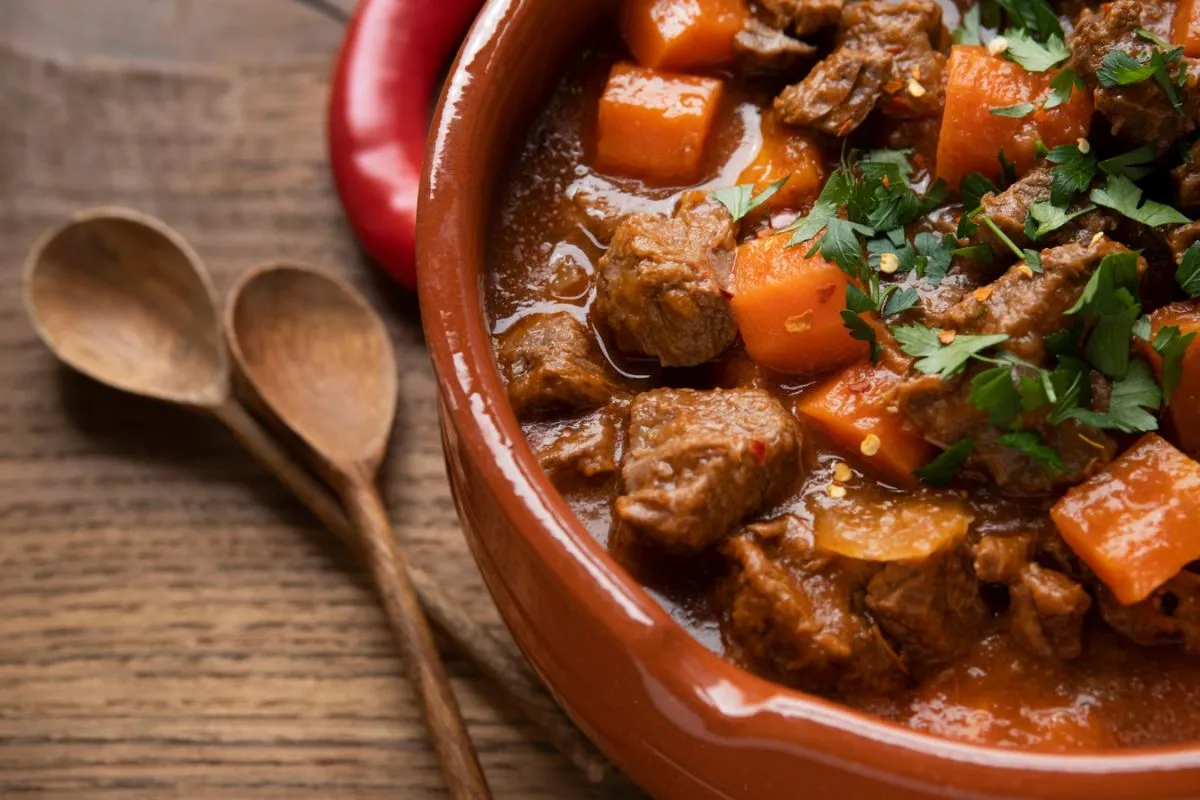
Overview of Caldo de Res
Caldo de Res is more than just a soup; it’s a rich, invigorating meal that combines simplicity with deep, comforting flavors. Usually prepared with beef shank or short ribs, the meat cooks slowly, allowing its savory juices to blend beautifully with fresh vegetables such as corn, carrots, potatoes, and cabbage. The result is a delightful symphony of flavors that not only satisfies hunger but also warms the soul.
Key Ingredients
Meat Varieties in Caldo de Res
The choice of meat is crucial in mexican beef recipe, as it forms the backbone of this dish’s rich flavor. Beef shank and short ribs are popular for their tenderness and ability to infuse the broth with a silky texture. These cuts are simmered for several hours, ensuring that all the savory flavors are extracted into the broth, creating a base that is both robust and enticing.
Vegetables Commonly Used
No Caldo de Res is complete without its array of colorful vegetables. Corn on the cob, cut into chunks, brings a sweet crunch that contrasts nicely with the soft, earthy potatoes and carrots. Chunks of cabbage add a slight bitterness that balances the richness of the meat. Each vegetable is chosen not only for its flavor but also for how its texture complements the broth, making every spoonful a delightful experience.
This introduction to the essential ingredients of Caldo de Res sets the stage for further exploration into its nutritional benefits and culinary variations. Stay tuned as we continue to uncover the secrets behind this beloved dish, ensuring your next bowl of Caldo de Res is as authentic and delicious as possible.
Learn more about traditional Mexican cooking techniques that can enhance your Caldo de Res.
Essential Ingredients of Caldo de Res
Caldo de Res, a cornerstone of Mexican cuisine, is celebrated for its hearty and nourishing ingredients. Understanding the essentials can help you capture the authentic taste and texture of this beloved dish.
Meat Varieties in Caldo de Res
Choosing the right meat is pivotal for the perfect Caldo de Res. Beef is the traditional choice, with cuts like shank, short ribs, or even oxtail offering rich flavors and a tender texture when slow-cooked. These cuts not only contribute a profound depth of flavor but also enrich the broth with gelatin, which gives the soup its characteristic body and heartiness.
Vegetables Commonly Used
The vegetable medley in mexican beef adds both nutrition and color to this rustic dish. Key vegetables include:
- Carrots: Sliced or chunked, carrots add a sweet note and vibrant color, enhancing the visual appeal and nutritional value.
- Potatoes: Typically cubed, potatoes absorb the flavors of the broth and contribute to the soup’s hearty texture.
- Cabbage: Chopped cabbage introduces a subtle bitterness that offsets the richness of the meat, providing a balanced flavor profile.
- Corn: Corn cobs, broken into smaller pieces, are a staple in this dish. They bring a juicy sweetness that complements the savory broth.
- Zucchini: This squash is a softer vegetable that cooks quickly, adding a mild flavor and lush green color to the pot.
Each vegetable is chosen to contribute not just taste and nutrition but also a variety of textures, making every bite interesting and satisfying.
Flavor Enhancers
While the meat and vegetables are fundamental, the true essence of Caldo de Res lies in the flavor enhancers:
- Garlic and Onion: Sauteed at the beginning, these aromatics provide a base flavor that permeates through the broth, giving it a rich and inviting aroma.
- Cilantro: Fresh cilantro is often added towards the end of cooking, lending a burst of freshness that brightens the earthy flavors of the meat and vegetables.
- Lime: A squeeze of lime juice before serving adds a tangy zest that enhances the overall flavor of the dish, cutting through the richness and balancing the heavy flavors.
To recreate authentic Mexican beef at home, understanding key ingredients and their interplay is crucial. Each component adds a unique touch, making Caldo de Res a robust and satisfying meal that comforts and delights.
Nutritional Value of Caldo de Res
Mexican beef recipe is not only a feast for the senses but also a nutritional powerhouse. This section breaks down the essential nutrients provided by this wholesome dish, highlighting its benefits for a balanced diet.
Calories and Macronutrients
A typical serving of Caldo de Res is rich in protein, primarily derived from the beef used as the main ingredient. Additionally, this protein aids in muscle repair and growth, making it an excellent choice for a post-workout meal. Moreover, our broth, infused with collagen from beef bones and connective tissues, offers a satisfying, nutrient-rich meal with minimal carbs and moderate calories.
- Protein: Beef stands as a prime reservoir of top-tier protein.
- Carbohydrates: Root vegetables add healthy carbohydrates, offering energy without overwhelming the dish with calories.
- Fats: While the cuts of beef used may contain some fat, much of it can be skimmed from the broth if preferred, making it adjustable for lower-fat diet preferences.
Vitamins and Minerals Present
The variety of vegetables in Caldo de Res contributes a range of vitamins and minerals essential for overall health:
- Vitamin A: Found abundantly in carrots, vitamin A is crucial for vision health and immune function.
- Vitamin C: Cabbage and potatoes provide vitamin C, which supports the immune system and acts as an antioxidant.
- Potassium: Potatoes and beef are good sources of potassium, important for heart health and muscle function.
- Iron: Beef is a significant source of iron, which is vital for creating red blood cells and preventing anemia.
Dietary Fiber
The fiber in this dish comes mainly from its vegetable ingredients. Fiber aids in digestion and can help regulate blood sugar levels, contributing to the overall health benefits of Caldo de Res:
- Cabbage and carrots provide both soluble and insoluble fiber, supporting digestive health and adding bulk to the diet, which helps in feeling fuller longer.
Health Benefits
Eating Caldo de Res can be particularly comforting during cold months, providing warmth and nourishment. The broth is hydrating, and the collagen it contains may help with joint health and skin elasticity.
Moreover, Caldo de Res’s reliance on simple, natural ingredients aligns with clean-eating diets, devoid of processed components. Traditional Mexican beef recipes highlight the nutritional benefits of slow cooking, extracting and retaining nutrients for a nourishing meal.
Creating the perfect Caldo de Res is an art that relies heavily on traditional cooking methods. These techniques not only enhance the flavor but also ensure that the nutrients are well-preserved, offering a meal that is as wholesome as it is delicious.
Preparing the Broth
The foundation of any good Caldo de Res is its broth. The process begins with choosing quality beef bones, which are rich in collagen and marrows, essential for a gelatinous, richly flavored broth. Here’s how to prepare it:
- Clean and Blanch the Bones: Start by rinsing the beef bones under cold water to remove any impurities. Next, briefly blanch them in boiling water and give them another rinse. This step helps in achieving a clearer broth.
- Slow Simmering: Place the cleaned bones in a large pot, cover with water, and bring to a boil. Once it reaches a boil, lower the heat to a gentle simmer. This slow cooking process allows the flavors to meld together and the essence of the bones to infuse the water, creating a deep, flavorful broth.
- Skimming: As the broth simmers, foam will rise to the surface. Skim this off regularly to ensure the broth remains clear and free from impurities.
Selecting and Preparing the Vegetables
Prepare the vegetables in Caldo de Res to maximize their flavor and texture:
- Chopping Uniformly: Cut the vegetables into uniform sizes to ensure they cook evenly. Larger chunks are typical for a rustic feel and to keep the vegetables from becoming too soft during the long cooking process.
- Adding at the Right Time: Add the root vegetables like carrots and potatoes early in the cooking process as they take longer to soften. More delicate vegetables, such as zucchini, should be added later to avoid overcooking.
Combining Ingredients
Once the broth is flavorful and the vegetables are prepared, it’s time to combine everything:
- Meat First: Add the meat to the broth first, as it takes longer to cook. This also allows the meat’s flavors to seep into the broth, enriching the overall taste.
- Vegetables Next: After the meat has been simmering for an appropriate amount of time, add the harder vegetables. Later, add the softer vegetables to ensure everything comes out perfectly tender yet intact.
Final Touches
To finish the dish, season the Caldo de Res with salt, pepper, and traditional spices such as cumin or Mexican oregano. Before serving, sprinkle freshly chopped cilantro to enhance freshness and squeeze lime juice for a zesty touch that enhances flavors.
Regional Adaptations of Mexican beef
Caldo de Res, rooted in traditional Mexican cuisine, offers various regional adaptations, reflecting diverse culinary landscapes. Each version retains the essence of the original while incorporating local flavors, giving each rendition a unique character.
Differences in Mexican States
In Mexico, the recipe for Caldo de Res can vary significantly from one state to another:
- Northern Mexico: In the arid regions of the north, the broth tends to be richer and more concentrated, often featuring robust ingredients like chiles and a greater variety of root vegetables to complement the beef.
- Southern Mexico: The southern states, with their lush, tropical climate, might include plantains or chayote in their version of Caldo de Res, adding a sweet or slightly tangy flavor to the broth.
- Central Mexico: Here, the dish is often more traditional, sticking closely to the basics of beef, corn, potatoes, carrots, and cabbage, but sometimes with the addition of rice to thicken the broth slightly.
Caldo de Res in Other Latin American Countries
The influence of this meal extends beyond Mexico, with variations found throughout Latin America:
- Guatemala: Locally known as “Caldo de Res Guatemalteco,” this version is similar to the Mexican style but may include additional spices like coriander and a stronger focus on root vegetables.
- Colombia: In Colombia, “Sancocho” is similar to Caldo de Res but often features chicken or fish along with a variety of local tubers and herbs, showcasing the country’s diverse agricultural offerings.
- Argentina: Argentinians might prepare a similar stew using more European-inspired ingredients such as parsley and bay leaves, enhancing the meaty flavor of the broth with various cuts of beef.
Adapting to Local Tastes
In each region, Caldo de Res adjusts to both available ingredients and local tastes, offering versatility for any occasion. Exploring these regional variations deepens appreciation and showcases the diversity of Latin American culinary traditions, making Caldo de Res a true celebration of Latin American cuisine.
How to Serve Caldo de Res
The presentation is as important as its preparation, enhancing the overall dining experience. This part of the guide will explore how to serve this hearty dish to captivate both the eyes and the palate, ensuring each bowl is as inviting as it is delicious.
Accompaniments and Garnishes
Caldo de Res typically serves as a full meal, and the right accompaniments can transform it from a simple soup to a feast. Here are some traditional and complementary options:
- Warm Corn Tortillas: Serve freshly warmed corn tortillas alongside the dish. They’re perfect for dipping into the broth or wrapping bits of meat and vegetables.
- Rice: A small bowl of cooked white rice can accompany the soup or be added directly into it to soak up the rich broth and add texture.
- Lime Wedges: Providing lime wedges allows diners to add zesty flavor to their soup, brightening the flavors and balancing the richness of the broth.
- Chopped Cilantro: Sprinkle fresh cilantro over the soup for a burst of color and a fresh herbal note that complements its deep flavors.
- Sliced Avocado: Offer creamy avocado slices as a garnish, providing a rich, buttery contrast to the hearty ingredients.
Plating Tips
Presentation plays a crucial role in serving Caldo de Res. Here’s how to plate it appealingly:
- Choose the Right Bowl: Opt for a deep, wide bowl that allows ample space for broth, meat, and vegetables. The bowl should be large enough to build a visually appealing dish without overcrowding.
- Layering: Start by placing the meat and the denser vegetables like potatoes and carrots at the bottom of the bowl. Then, ladle the hot broth over these, allowing the lighter ingredients like cabbage and zucchini to float attractively on top.
- Garnishing: Garnish just before serving to maintain the vibrant colors and textures of the herbs and lime. A small pile of chopped cilantro and a few slices of avocado on top can significantly enhance the visual appeal.
The Cultural Significance of Caldo de Res
Mexican beef recipe represents more than beef and vegetable soup; it embodies a diverse culinary tradition across Mexico and Latin America. Each bowl evokes family warmth, festive joy, and home comfort.
A Dish of Heritage and Nourishment
Rooted in Mexican culture, Caldo de Res symbolizes hospitality and community, bringing people together for special occasions.
Adaptability Across Borders
Its adaptability to regional tastes showcases traditional cuisine’s dynamic nature, embracing new influences and cultural exchange.
Health Benefits in a Bowl
Besides its cultural significance, Mexican beef recipe provides various health benefits. It’s loaded with nutrients from a diverse range of vegetables and beef, offering vitamins, minerals, and protein in a tasty and easily digestible form. The collagen-rich broth is soothing for the gut and may aid in boosting immunity and reducing inflammation.
Preserving and Sharing the Tradition
Exploring global cuisine, dishes like Caldo de Res reflect rich traditions, enhancing our dining experiences and preserving heritage.
Frequently Asked Questions
What are the most common vegetables in caldo de res?
The most common vegetables found in Caldo de Res include carrots, potatoes, corn, and cabbage. Each brings its unique flavors and textures to the soup, contributing to its hearty and wholesome profile. Some variations might also include chayote, zucchini, or green beans, depending on regional preferences.
What type of meat is best for caldo de res?
Traditionally, Caldo de Res is made with beef, particularly tougher, meatier cuts like shank, brisket, or short ribs. Slow cooking breaks down connective tissues in these cuts, enhancing broth flavor and resulting in tender meat pieces.
Can caldo de res be made vegetarian?
Certainly! To make Caldo de Res vegetarian, skip the beef and use vegetable broth. Add protein-rich veggies like mushrooms or beans and extra root vegetables for depth and texture.
How long does it take to cook ?
Typically requires a few hours of cooking time, generally about 2 to 3 hours, to ensure that the meat is tender and the flavors are well-developed. The exact time can vary based on the cut of meat and the size of the vegetable pieces.





